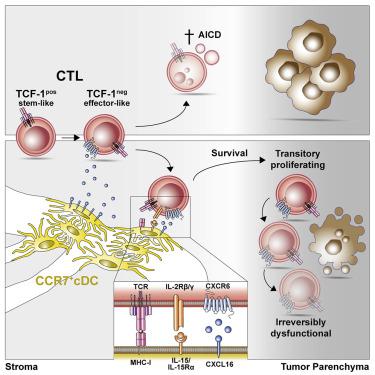Cell ( IF 64.5 ) Pub Date : 2021-08-02 , DOI: 10.1016/j.cell.2021.07.015 Mauro Di Pilato 1 , Raphael Kfuri-Rubens 2 , Jasper N Pruessmann 3 , Aleksandra J Ozga 3 , Marius Messemaker 4 , Bruno L Cadilha 5 , Ramya Sivakumar 6 , Chiara Cianciaruso 7 , Ross D Warner 8 , Francesco Marangoni 3 , Esteban Carrizosa 3 , Stefanie Lesch 5 , James Billingsley 9 , Daniel Perez-Ramos 10 , Fidel Zavala 10 , Esther Rheinbay 11 , Andrew D Luster 3 , Michael Y Gerner 6 , Sebastian Kobold 12 , Mikael J Pittet 13 , Thorsten R Mempel 14

|
Cytotoxic T lymphocyte (CTL) responses against tumors are maintained by stem-like memory cells that self-renew but also give rise to effector-like cells. The latter gradually lose their anti-tumor activity and acquire an epigenetically fixed, hypofunctional state, leading to tumor tolerance. Here, we show that the conversion of stem-like into effector-like CTLs involves a major chemotactic reprogramming that includes the upregulation of chemokine receptor CXCR6. This receptor positions effector-like CTLs in a discrete perivascular niche of the tumor stroma that is densely occupied by CCR7+ dendritic cells (DCs) expressing the CXCR6 ligand CXCL16. CCR7+ DCs also express and trans-present the survival cytokine interleukin-15 (IL-15). CXCR6 expression and IL-15 trans-presentation are critical for the survival and local expansion of effector-like CTLs in the tumor microenvironment to maximize their anti-tumor activity before progressing to irreversible dysfunction. These observations reveal a cellular and molecular checkpoint that determines the magnitude and outcome of anti-tumor immune responses.
中文翻译:

CXCR6 定位细胞毒性 T 细胞以接收肿瘤微环境中的关键生存信号
针对肿瘤的细胞毒性 T 淋巴细胞 (CTL) 反应由干细胞样记忆细胞维持,这些细胞可以自我更新,但也会产生效应样细胞。后者逐渐失去抗肿瘤活性并获得表观遗传固定的功能低下状态,从而导致肿瘤耐受。在这里,我们表明,茎样 CTL 转化为效应器样 CTL 涉及主要的趋化重编程,其中包括趋化因子受体 CXCR6 的上调。该受体将效应器样 CTL 定位在肿瘤基质的离散血管周围微环境中,该微环境被表达 CXCR6 配体 CXCL16 的CCR7 +树突状细胞 (DC)密集占据。CCR7 + DC 还表达并反式呈递存活细胞因子白介素-15 (IL-15)。CXCR6表达和IL-15反式呈递对于肿瘤微环境中效应样CTL的存活和局部扩张至关重要,以在发展为不可逆功能障碍之前最大化其抗肿瘤活性。这些观察结果揭示了决定抗肿瘤免疫反应的强度和结果的细胞和分子检查点。


























 京公网安备 11010802027423号
京公网安备 11010802027423号